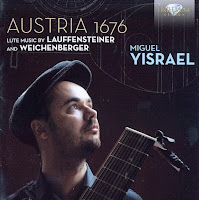1676 was an important year for European lute music – Thomas Mace published his famous volume Musick’s Monument, and the two Austrian composers and lutenists Wolff Jacob Lauffensteiner and Johann Georg Weichenberger were born.
Although these composers’ works were stylistically similar to the German school of lute music, they carved out a distinct and independent Austrian movement; this new recording by acclaimed lutenist Miguel Yisrael celebrates their achievements through a programme dedicated to their partitas.
Although these composers’ works were stylistically similar to the German school of lute music, they carved out a distinct and independent Austrian movement; this new recording by acclaimed lutenist Miguel Yisrael celebrates their achievements through a programme dedicated to their partitas.
Lute music was, in fact, a central part of Austrian culture in the 17th and 18th centuries: the Habsburgs, for example, played the instrument and employed virtuoso musicians to compose and perform for them. In addition to this, Lauffensteiner and Weichenberger were also exposed a wealth of stylistic influences, primarily the intricate French style of lute playing and the emerging Italian style, which featured a greater emphasis on melody. This rich combination of influences is embodied in their music – idiomatic works blending French textures with song-like melodies that foreshadow the 18th-century galant style. This recording is a valuable snapshot of the uniquely Austrian style of lute playing that Lauffensteiner and Weichenberger established. Miguel Yisrael’s performances demonstrate a deep resonance with this repertoire, and reveal his exemplary approach to the technical and stylistic intricacies of his instrument.


